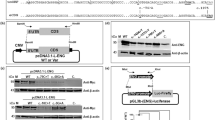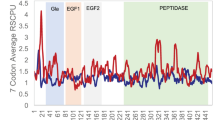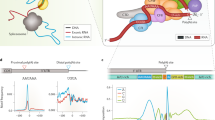Abstract
The G→A mutation at position 20210 of the prothrombin or coagulation factor II gene (F2) represents a common genetic risk factor for the occurrence of thromboembolic events1,2,3. This mutation affects the 3′-terminal nucleotide of the 3′ untranslated region (UTR) of the mRNA and causes elevated prothrombin plasma concentrations1,2,3,4 by an unknown mechanism. Here, we show that the mutation does not affect the amount of pre-mRNA, the site of 3′ end cleavage or the length of the poly(A) tail of the mature mRNA. Rather, we demonstrate that the physiological F2 3′ end cleavage signal is inefficient and that F2 20210 G→A represents a gain-of-function mutation, causing increased cleavage site recognition, increased 3′ end processing and increased mRNA accumulation and protein synthesis. Enhanced mRNA 3′ end formation efficiency emerges as a novel principle causing a genetic disorder and explains the role of the F2 20210 G→A mutation in the pathogenesis of thrombophilia. This work also illustrates the pathophysiologic importance of quantitatively minor aberrations of RNA metabolism.
This is a preview of subscription content, access via your institution
Access options
Subscribe to this journal
Receive 12 print issues and online access
$209.00 per year
only $17.42 per issue
Buy this article
- Purchase on Springer Link
- Instant access to full article PDF
Prices may be subject to local taxes which are calculated during checkout




Similar content being viewed by others
References
Poort, S.R., Rosendaal, F.R., Reitsma, P.H. & Bertina, R.M. A common genetic variation in the 3′-untranslated region of the prothrombin gene is associated with elevated plasma prothrombin levels and an increase in venous thrombosis. Blood 88, 3698–3703 (1996).
Makris, M. et al. Co-inheritance of the 20210A allele of the prothrombin gene increases the risk of thrombosis in subjects with familial thrombophilia. Thromb. Haemost. 78, 1426–1429 (1997).
Tosetto, A., Missiaglia, E., Frezzato, M. & Rodeghiero, F. The VITA project: prothrombin G20210A mutation and venous thromboembolism in the general population. Thromb. Haemost. 82, 1395–1398 (1999).
Cattaneo, M., Chantarangkul, V., Taioli, E., Santos, J.H. & Tagliabue, L. The G20210A mutation of the prothrombin gene in patients with previous first episodes of deep-vein thrombosis: prevalence and association with factor V G1691A, methylenetetrahydrofolate reductase C677T and plasma prothrombin levels. Thromb. Res. 93, 1–8 (1999).
Lane, D.A. & Grant, P.J. Role of hemostatic gene polymorphisms in venous and arterial thrombotic disease. Blood 95, 1517–1532 (2000).
Ross, J. & Pizarro, A. Human beta and delta globin messenger RNAs turn over at different rates. J. Mol. Biol. 167, 607–617 (1983).
Salles, F.J., Richards, W.G. & Strickland, S. Assaying the polyadenylation state of mRNAs. Methods 17, 38–45 (1999).
Chou, Z.F., Chen, F. & Wilusz, J. Sequence and position requirements for uridylate-rich downstream elements of polyadenylation signals. Nucleic Acids Res. 22, 2525–2531 (1994).
Colgan, D.F. & Manley, J.L. Mechanism and regulation of mRNA polyadenylation. Genes Dev. 11, 2755–2766 (1997).
Zhao, J., Hyman, L. & Moore, C. Formation of mRNA 3′ends in eukaryotes: mechanism, regulation, and interrelationships with other steps in mRNA synthesis. Microbiol. Mol. Biol. Rev. 63, 404–445 (1999).
Chen, F., MacDonald, C.C. & Wilusz, J. Cleavage site determinants in the mammalian polyadenylation signal. Nucleic Acids Res. 23, 2614–2620 (1995).
Batt, D.B., Luo, Y. & Carmichael, G.G. Polyadenylation and transcription termination in gene constructs containing multiple tandem polyadenylation signals. Nucleic Acids Res. 22, 2811–2816 (1994).
van Hoof, A. & Parker, R. The exosome: a proteasome for RNA? Cell 99, 347–350 (1999).
Burkard, K.T. & Butler, J.S. A nuclear 3′-5′ exonuclease involved in mRNA degradation interacts with poly(A) polymerase and the hnRNA protein Npl3p. Mol. Cell. Biol. 20, 604–616 (2000).
Muhlrad, D. & Parker, R. Aberrant mRNAs with extended 3′ UTRs are substrates for rapid degradation by mRNA surveillance. RNA 5, 1299–1307 (1999).
Thermann, R. et al. Binary specification of nonsense codons by splicing and cytoplasmic translation. EMBO J. 17, 3484–3494 (1998).
Sambrook, J., Fritsch, E.F. & Maniatis, T. Molecular Cloning: A Laboratory Manual (Cold Spring Harbor Laboratory Press, Cold Spring Harbor, NY, 1989).
Neu-Yilik, G. et al. Splicing and 3′end formation in the definition of nonsense-mediated decay-competent human beta-globin mRNPs. EMBO J. 20, 532–540 (2001).
Kugler, W., Enssle, J., Hentze, M.W. & Kulozik, A.E. Nuclear degradation of nonsense mutated beta-globin mRNA: a post-transcriptional mechanism to protect heterozygotes from severe clinical manifestations of beta-thalassemia? Nucleic Acids Res. 23, 413–418 (1995).
Acknowledgements
The work of these authors was financially supported by the Deutsche Forschungsgemeinschaft (DFG) and the Fritz-Thyssen-Stiftung.
Author information
Authors and Affiliations
Corresponding author
Rights and permissions
About this article
Cite this article
Gehring, N., Frede, U., Neu-Yilik, G. et al. Increased efficiency of mRNA 3′ end formation: a new genetic mechanism contributing to hereditary thrombophilia. Nat Genet 28, 389–392 (2001). https://doi.org/10.1038/ng578
Received:
Accepted:
Published:
Issue Date:
DOI: https://doi.org/10.1038/ng578
This article is cited by
-
Context-specific regulation and function of mRNA alternative polyadenylation
Nature Reviews Molecular Cell Biology (2022)
-
Alternative cleavage and polyadenylation in health and disease
Nature Reviews Genetics (2019)
-
Genome-wide atlas of alternative polyadenylation in the forage legume red clover
Scientific Reports (2018)
-
Improvement of the transient expression system for production of recombinant proteins in plants
Scientific Reports (2018)
-
The effects of Factor II (rs1799963) polymorphism on recurrent pregnancy loss in Iranian Azeri women
La Rivista Italiana della Medicina di Laboratorio - Italian Journal of Laboratory Medicine (2017)



